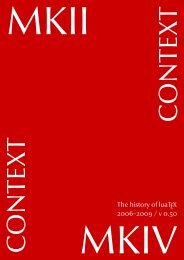ConTEXt an excursion - Pragma ADE
ConTEXt an excursion - Pragma ADE
ConTEXt an excursion - Pragma ADE
Create successful ePaper yourself
Turn your PDF publications into a flip-book with our unique Google optimized e-Paper software.
Paragraph formatting<br />
\chemical{CaCO_3,˜,GIVES,˜,CaO,˜,+,˜,CO_2}<br />
\stopchempar<br />
And it would come out like this:<br />
Limekilns Hasselt has its own limekilns. These CaCO 3<br />
−→ CaO + CO 2<br />
were build in 1504 <strong>an</strong>d produced<br />
quick lime up to 1956. Nowadays<br />
they are a tourist attraction.<br />
By the way you could also type it in a more cryptic way:<br />
\chempar Limekilns<br />
\\ Hasselt has its own limekilns. They were build in 1504 <strong>an</strong>d<br />
produced quick lime up to 1956. Nowadays they form a<br />
tourist attraction.<br />
\\ \chemical{CaCO_3,˜,GIVES,˜,CaO,˜,+,˜,CO_2} \\<br />
contents<br />
index<br />
comm<strong>an</strong>ds<br />
definitions<br />
colofon<br />
The \\ are used as column separators <strong>an</strong>d are essential.<br />
The chemical module is explained in <strong>an</strong>other m<strong>an</strong>ual, because not everybody is interested<br />
in chemical stuff. However, chemical structures always look impressive.<br />
O<br />
O<br />
H 3 C<br />
C<br />
C<br />
H<br />
C<br />
H<br />
C<br />
C<br />
CH 3<br />
H 3 C<br />
C<br />
N<br />
C<br />
CH 3<br />
H<br />
Compound A<br />
CONT E XT relies on the P I CT E X macros of M.J. Wichura to draw this kind of structure. Although<br />
the chemical module consists of only two or three comm<strong>an</strong>ds, it takes some practice to<br />
get the right results. This is how the input looks:<br />
\placeformula[-]<br />
\startformula<br />
exit<br />
search +<br />
go back<br />
– +<br />
12 49
















